Following a break in Florida about fifteen months ago when our son, Lee, had a succession of near misses, we were persuaded to go again so Lee could address his “unfinished business” catching many of the species that he had lost with particular emphasis on tarpon. The time to catch the big ones is around Easter when they travel from the Atlantic through the Florida Keys into the Gulf of Mexico, and the best place to fish for them is Islamorada, roughly in the middle of the Keys.
We decided to book through John Rawle who I have fished with previously, and in whom I have the utmost confidence, a decision that was to prove correct late in the trip.
Having arrived on the Monday evening from the UK flying Delta from Heathrow and then collecting our hire car we had pre-booked; this saves a great deal of money. If you go to Florida now, the toll roads don’t take cash so make sure your hire car is fitted with one of the electronic passes, it makes life so much easier. We also make sure that the insurance excess is covered; it cost us a fortune when our car was broken into in Canada. We drove down to the Keys taking about two hours. Distances might look small on a map of the USA but it is a big country with slow speed limits.
Having stayed in Florida before, and knowing that the food was mostly of the fast variety, we stopped at a supermarket on the way down. The food here was still expensive compared to the UK, and although it looked good, the taste was not what we are used to in the UK, especially the cheese which is all processed, and there is spray on cheese too!!
We arrived at John’s house where we were staying for the week in the evening. This is very convenient for the tarpon trips which start from 3am (They feed better in the dark) and we were booked for our first trip on the next morning.
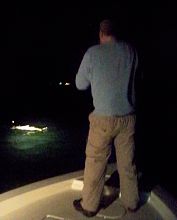
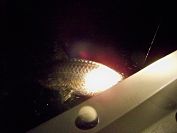
Lee and I staggered out of bed and onto John’s boat moored in the channel at the end of the garden, as most seem to be in the Keys, we then headed just a few hundred yards around the bay and Oceanside of Channel 2. As we slowed we could hear the slaps of tarpon taking off the surface. The method John chose was to fish crabs with a circle hook through a protrusion in the shell with a float about four feet above. The float isn’t used as a bite indicator, but to stop the crab from swimming down into the weed keeping it on or just below the surface. Tarpon are surface feeders but lie just off the bottom watching for anything drifting over them, rising up to attack the bait. John started the drift and we quickly had four takes, all of which we missed due to our lack of technique, but then we hit all of the next five catching tarpon from 40 to 90lbs. Exhilarating hard fighting fish but not big for the time of year when 100lb’ers are regularly caught. We returned to the house a little after 7am for breakfast, chilling out in the morning sunshine.
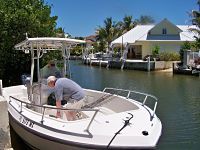
Another couple of anglers, Arthur and Dave, were also staying at the house and had hired a boat for their own excursions between the scheduled sessions with John. They asked if we would like to join them for a trip shark fishing off one of the sand bars. Never one to turn down a fishing trip, we readily agreed and hopped on board for an afternoon session leaving Sandy behind once again. (I’m so lucky that she has got used to me over the years).
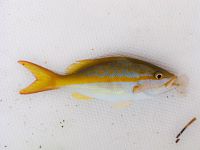
We went about 10 miles into the gulf next to a sand bar where the deepest section was about 5 to 6 feet deep, dropped anchor and put the chum over the side. As this spread across the water, we baited up with bits of squid to catch our bait. We caught a range of fish including ballyhoo, pinfish, gray and yellowtail snapper and pilchard.
The ballyhoo are a good bait being an oily fish and we tackle up the shark rods fitted with 65lb braid and a deadbait and set the multiplier on free spool with just the check to register the bite. Then I carried on catching bait whilst the other anglers waited for the shark.

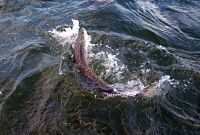
Lee was the first to get a good run and after a fast action tussle landed a barracuda of just over 20lb. The same rod had the next run which Lee suggested I took. The rod whipped over double as something slowly powered away stripping line from the reel. Over the next fifteen to 20 minutes there was much pulling too and fro until a loggerhead turtle poked its head into the air, I’d obviously hooked him on the shell, but his head was bigger than mine so he was a good sized specimen. I couldn’t get it to the boat as he was just too strong, and eventually the shark hook snapped in two. As one would expect aboard a boat of anglers, the mickey taking then started in earnest.
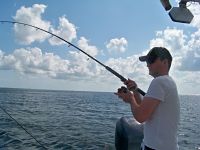
The bait was recast, and then one of the other reels screeched as the line was pulled off. Lee struck into a very fast moving shark, probably a black tip, which stripped line at a prodigious rate before everything went slack. Lee, dispirited, started to retrieve his tackle before realising the shark was still on and had just turned and ran at the boat at high speed. However, there was so much slack in the line that the fish was able to shed the hook.
That ended an enjoyable afternoon, not the greatest for fish, but a boat shared with like minded company is always interesting and enjoyable.
We returned home to share a barbecue with Sandy in the garden before settling by the channel at the rear of the house with deadbaits out on light tackle catching snappers, the biggest being a little over 2lb, and hardhead catfish.
We hadn’t got any trips scheduled for the following day, so we all went out together stopping first at Worldwide Sportsman, an angling shop the size of a UK department store with a replica of Hemingway’s boat as a centrepiece and a restaurant dedicated to Zane Grey who fished from Long Key. There are even a collection of Hardy Zane Grey reels on display worth around $10,000 each!!
We then went for Lunch at Robbie’s, the shack in Islamorada where you can view and feed the tarpon. What a treat!! We finished the day with a little more shopping followed by a meal back at John’s before Lee and I ended the day deadbaiting from the back of the house catching snapper and schoolmaster.

As dusk fell, Lee shouted out that the bottom of the channel was moving, until he realised that a manatee had come to visit. Knowing that these animals like fresh water, we turned on the hose and it immediately came up for a drink to the delight of all the house occupants. A lettuce was quickly found and hand fed to the adolescent manatee (only about 7-8 feet long) who allowed everyone to stroke it, some even getting in the channel with it. This was definitely one of the highlights of the stay.
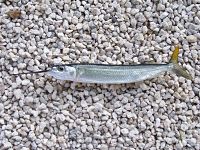
The next day, we rose late as Lee and I had a shark trip arranged for around midday with John, who had already bought chum from the local fishmongers. He explained that we would have to catch fresh bait and may have to go past the shark mark to get this. We tried a couple of close areas with limited succeed catching a couple of ladyfish and snapper before going out to the distant mark in a sand hole with a large central rock. John caught a houndfish, whilst Lee and I caught snappers and a few small gag grouper and ballyhoo and it didn’t take long to catch the days bait. I always enjoy these sessions because you never know just what you are going to catch. There are so many different species here and they all seem to eat the shrimp which we used as bait, lightly leaded to aid casting.
We were now ready for the shark fishing. John took us out to the same bar that we had visited two days earlier, but with his shallower boat, he parked using a pole right in the middle of a gap in the sand bar. Here the current ran at about 4mph as against 0.5mph if you move a little way away, this helps spread the smells from the chum over a large area more quickly. It didn’t take long for the first shark to show, but we were told not to cast yet, we had to wait for a few more to show to get competition between the fish for the food; this would give us the best chance of them not detecting the tackle.
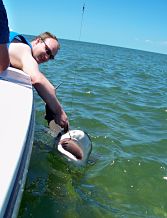
After about 20 minutes, we cast and a spinner shark quickly descended upon my bait but rejected it. Upon retrieval, it became clear why, there was a big mass of weed that had surrounded the bait from the flow through the bar. This was removed and the bait recast quickly.
By now the sharks were next to the boat and Lee was into a lemon shark. This was his first shark, and a good one to learn on as they aren’t the most dynamic of fighters, but do have the strength associated with the size. After John unhooking it at the side of the boat and photographs taken, Lee cast again.

This time he was in to a good sized spinner shark which screamed away from the boat. These are reputed to be exciting, hard fighting fish and this one didn’t let us down. The first run was about 250 yards with five leaps clear of the water doing the barrel roll after which they are named. Lee hung on for dear life and gradually started regaining line. It was at this point that I hooked into a large lemon shark which powered away in a slower determined way and crossed the sand bar. Playing the fish on the other side wasn’t easy as I had limited control but gradually kept the pressure on until it returned to the gap in bar whilst Lee was walking around the boat as the spinner circled the boat. It was a lively time.
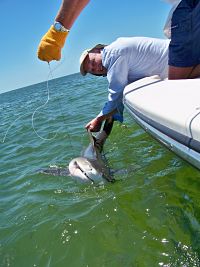
As the tide weakened, John decided to excite the sharks but pouring in the last of the chum, and this brought the shark tugging at the chum tied to the boat. We both dropped out bait just over the back and were immediately into a fish each. After a few moments we realised that our lines were tangled as we were attached to the same fish, a medium sized lemon shark of around 120lb. I told Lee it was my fish and slacken off, and he argued it was his until we got it to the boat and saw it had taken both baits and had one hook in either side of the mouth. With both of us pulling, it got to the boat quickly which gave John the problem of unhooking a fish that was still thrashing about, but he is very professional and just took it steadily and gently returned the fish.
The highlight of the tri[p for me was seeing a shark fin breaking the surface in the “Jaws” style as it approached the boat, and I was surprised at the spray coming off the front of the fin as it swam at speed.
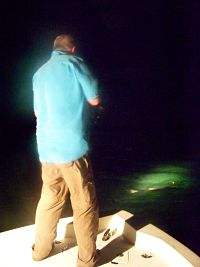
We had two early morning tarpon sessions left, the first with Jeff Pfister. The wind had risen which made the fishing more difficult. The tarpon are sight feeders and turbulence on the surface acts a cloud making less likely the tarpon will see the bait, and as a result we had less takes with only one fish being caught. This was a large one I hooked and played before we realised it was a good fish. In the area was a team from Florida University wishing to tag large fish to find out growth rates, movements etc. Jeff contacted them and after 10 minutes of so, they clambered aboard when I was still playing the fish. The fight went on and on with the fish refusing to come to the boat. It even dragged us onto a sand bar and beached the boat. It took over an hour playing the fish on 65lb braid to bring it alongside. Jeff joked that I was pulling so hard that had the line snapped I would have catapulted overboard. The leader was then held, but as they tried to lift the fish into the boat to measure it, the fish flipped, broke free and smashed the line. At least we got a good view at all 140lb of it. By the time we got off the bar and sorted everything out there was little time left for Lee to catch any more fish.
In the evening Sandy wanted to go to listen to live music in the Green Turtle restaurant. However, it didn’t start until 10 so we travelled a little further up to Lorelei for our first stop with Rob and Adele, other guests at John’s house and Rob had drawn the short straw, doing the driving. We then returned a short distance to the Islamorada Fish Company, another restaurant where there was a guitar playing singer. We settled down with a few refreshments, and listened to his wide repertoire, including a few suggestions from ourselves. By the time he finished we were a little worse for wear and headed home ready for our 3 am fishing trip with John the following morning. We tried off Lignum Vitae hoping to find a less windy area. Initially we had the entertainment of watching an American skipper with a client who had hooked a tarpon, trying to play it to the boat by chasing it for nearly two hours with no success. If you don’t tire the fish out through the exertion of the angler, you will never get them in and the longer the fight lasts, the more frayed the line becomes until it fails. They do this for several reasons:-
a) They always tell the client it was a huge fish and they have the tale of the monster that got away. In reality, any fish over 70 lb will probably escape.
b) Crab cost between $2.5 and $3 ea so the long fight saves them money.
c) They don’t have to worry about finding another fish as the angler normally doesn’t want to catch another fish and play it for another couple of hours.
So only the guide wins, as the angler suffers and it can’t be good for the fish.
We made the right decision choosing John as he likes to catch as many fish as possible and you can normally get them in within 25 minutes apart from the really stubborn ones (like the previous day). We were struggling for takes in the wind, and hardly anybody was catching anything, so John advised us to take the float off to let the crab to settle lower in the water, hoping it would drift underneath the layer of turbulence. I had never heard of doing this before, but it worked and in the next hour, both Lee and I had good fish. I had one of 135lb and Lee had one of 125lb. I then changed rod and missed a third run as the clutch wasn’t set correctly. So we had a really good session in demanding conditions.
The weeks fishing had finished on a high note and as ever, I was really impressed with John’s skills and his attention to detail. Little tricks like making a hole in the shell of the crab with an old hook so the actual ones remain keen, and having a bucket on the deck to put the crab in between drifts so that they remain fresh for longer all helps. Tarpon have an incredibly hard mouth and any edge you can get must be worthwhile, and John seems to catch more than most. These also inspire great confidence, which the size and number of fish we caught prove wasn’t misplaced.